*updated
On 6 February, a series of devastating and massive earthquakes with epicentres in southern Turkey also struck northwest Syria, home to four million people who have been displaced by more than a decade of war and are already in need of humanitarian aid. Numerous buildings collapsed in the earthquakes, and up to 8,500 Syrians died.
The areas most affected by the earthquakes on the Syrian side were divided between government territories and lands controlled by Turkish-backed opposition groups. The ongoing conflict in the country and US and European sanctions against Syria have made it much more difficult for humanitarian aid to reach quake-stricken areas.
The earthquakes caused casualties and infrastructure damage in Kurdish-led areas of northeastern Syria too, although losses were minor compared to Turkey and other parts of Syria. Political rifts and rivalries would also lead to new challenges for humanitarian efforts offered by the Autonomous Administration of North and East Syria (AANES).
The regions that suffered worst from the disaster, with a confirmed death toll of over 4,500, were the regions under the control of opposition groups, where the civil war was also most intense. Most of the collapsed buildings had already been weak due to structural damage from years of clashes.
The danger from the regrouping of the dormant Islamic State (ISIS) cells, having taken advantage of vulnerabilities caused by the earthquakes, made the crisis in the region even more tragic.
Here is a timeline of one of the deadliest natural disasters to strike the region this century.
[see also: Earthquakes diary: Turkey | In the aftermath of a disaster]
Monday, 6 February
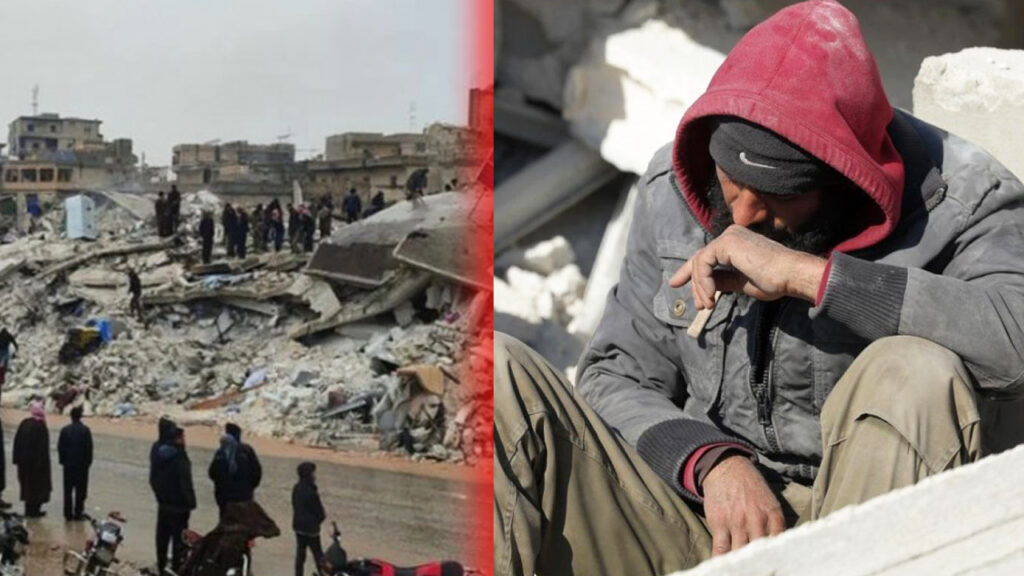
Two massive earthquakes measuring 7.8 and 7.7 on the Richter scale hit southeast Turkey and northern Syria, killing thousands and levelling buildings. The first quake rocked the region before dawn when most people were sleeping. In the meantime, strong aftershocks with magnitudes of over 6 kept coming.
A Syrian health official announced that according to the first findings more than 230 people had died in government-controlled areas, mostly in Hama, Aleppo and Latakia provinces. Sky News, citing rescuers, reported that at least 147 people had died in opposition-held areas of northwest Syria. Hospitals in the region were overwhelmed with patients.
Six people died and 57 were injured in the Kurdish-led northeast. The co-chair of the AANES Health Board, Jiwan Mustafa, stated that all the deaths and 44 of the injuries had occurred in the Sheikh Maqsoud district of the city of Aleppo, while seven of the injuries were in Shahba, four in Kobane and two in Manbij. AANES-controlled areas were ready to provide medical care to people outside the region as well as to North and East Syria, Mustafa said.
The Kurdistan Red Crescent Society (Heyva Sor a Kurdistanê) launched an aid campaign to meet the urgent needs of victims in the earthquake region.
Mazloum Abdi, commander of the Syrian Democratic Forces (SDF), offered help to regions hit by the earthquake.
The International Rescue Committee (IRC) called on the international community to increase funding to war-torn Syria. “The impact has been devastating in areas that already host a high number of displaced and vulnerable families. This tragic incident comes just after the country was hit by a snowstorm that has seen temperatures plummet,” said the IRC and warned of thousands at risk as the search and rescue operations were ongoing.
Tuesday, 7 February
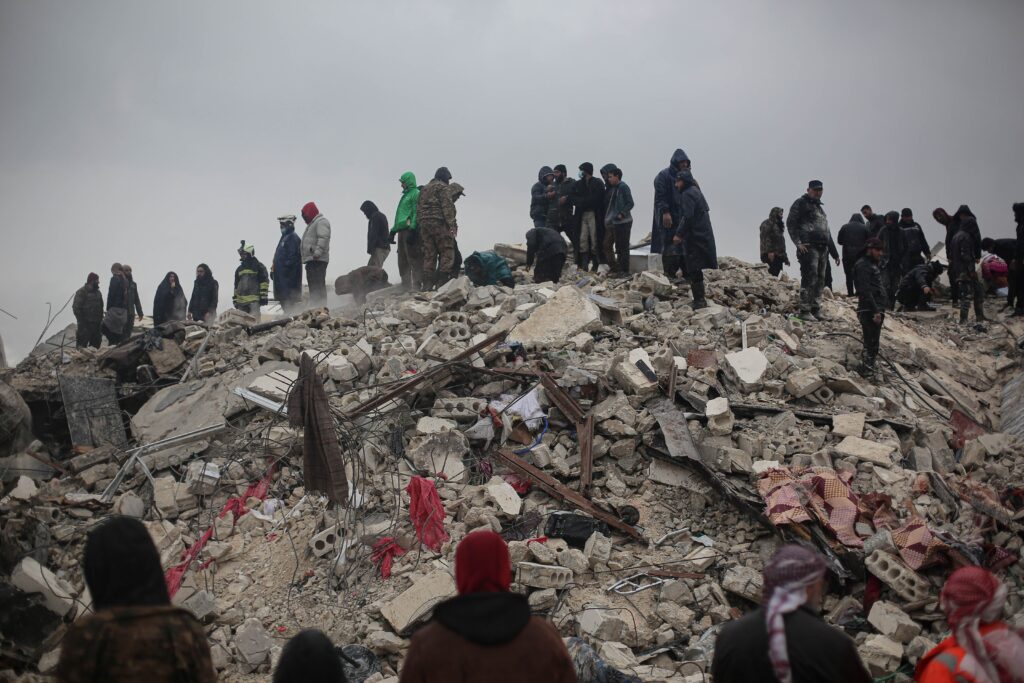
The impact of the earthquake in Syria was exacerbated by the destruction of 12 years of war which has left many buildings in the country’s north structurally weak. Hundreds of families were still trapped under the rubble, while harsh weather conditions and fuel shortages hindered rescue efforts.
Turkey’s ongoing aggression towards the Kurdish forces did not ease despite the calamity. Turkish forces shelled the area around the town of Tel Rifat in the northern countryside of Aleppo in Syria in the early hours of Tuesday.
The World Health Organisation (WHO) declared a Level Three Emergency and mobilised its assets.
The flow of aid from Turkey to the northwest of Syria stopped temporarily due to the damaged roads.
Europe regional director of WHO Dr Hans Kluge called on the international community to create a humanitarian corridor and to reopen the Bab al-Hawa border crossing point between Turkey and Syria.
Syria’s ambassador to the UN said that any outside assistance for earthquake victims must be done in coordination with Damascus and delivered from within Syria, not across the Turkish border.
The Damascus-based Syrian Red Crescent said it was ready to deliver aid across Syria, including to opposition areas.
The US Central Command said it has been in close coordination with SDF to “surge support” to those affected by the earthquake.
Twenty members of ISIS used the earthquakes as an opportunity to escape from a prison in the town of Rojo. The prison, controlled by a Turkish-backed rebel faction housed about 2,000 prisoners, the majority of whom were ISIS members, while the rest were mainly fighters from Kurdish groups.
Cracks and fissures emerged on the Maydanki dam in the northern Syrian city of Afrin, after the region was hit by two major earthquakes on Monday. Authorities have closed access to the area. The dam, also known simply as the Afrin dam, provides drinking water for almost 200,000 people and is the main source of irrigation for local agricultural production.
Wednesday, 8 February
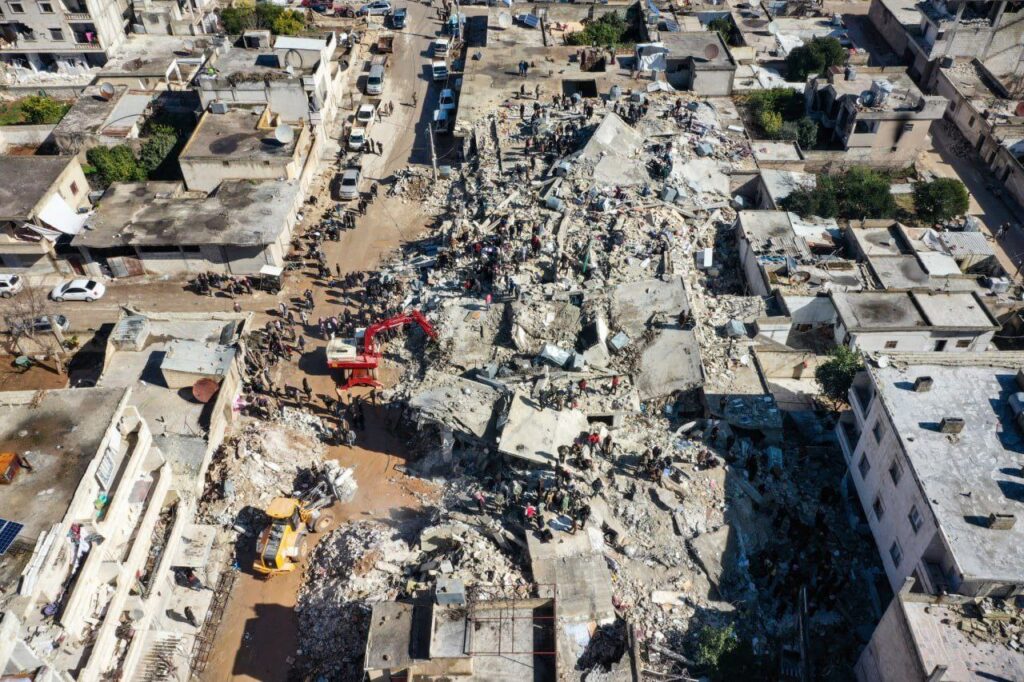
The northern Syrian cities of Afrin and Idlib had received no international or UN humanitarian support 56 hours after the devastating earthquakes. The UN said it was unable to send aid to the affected region due to damage from the earthquakes, but local sources told North Press Agency that “all routes linking between the border and the UN warehouses in Turkey are passable and nothing curbs the aid entry.”
The Syrian government called for the lifting of sanctions imposed by the United States and other countries. However, on Monday, US State Department Spokesman Ned Price had told reporters that it would be “ironic, if not even counterproductive, for us to reach out to a government that has brutalized its people over the course of a dozen years now”.
The Iraqi government sent relief materials on planes to Damascus. While the Barzani Charity Foundation sent aid to northern Syria as well, local sources reported that two lorries from an NGO run by Iraqi Kurdistan’s ruling family were stopped in Turkey’s Gaziantep province, with Turkish officials saying all aid to Syria must go through Turkey’s official channels as the UN had no presence in the region.
The European Union announced it would hold a donor conference in March to provide relief aid to Syria.
Thursday, 9 February
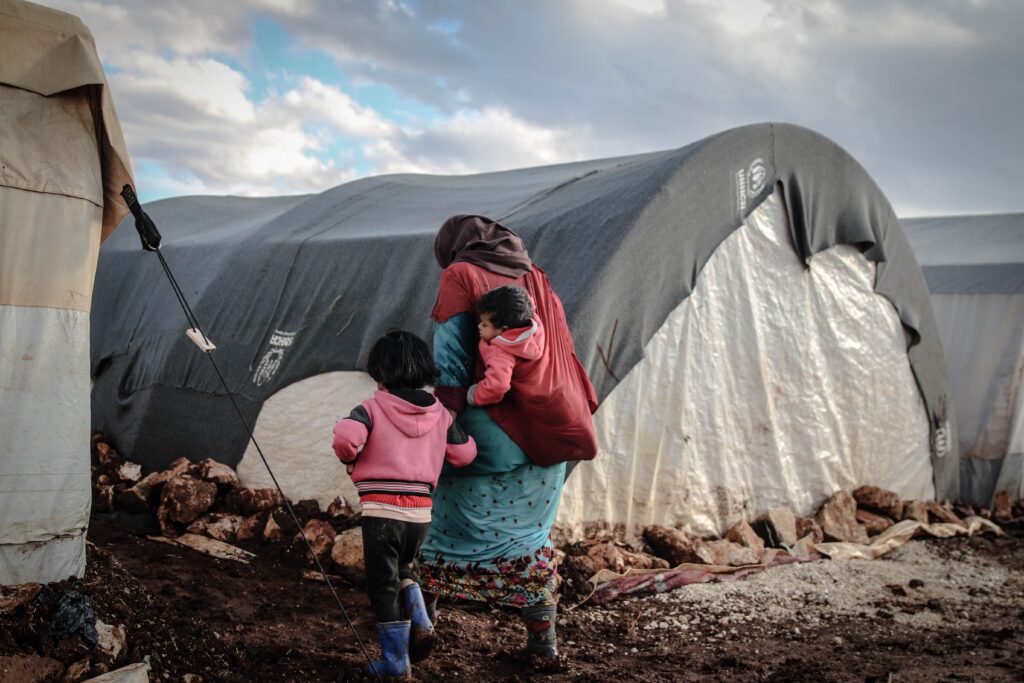
An aid convoy consisting of six lorries reached northwest Syria. This was the first humanitarian aid to reach the region, which was under the control of Turkey and the Syrian opposition.
Meanwhile, the Syrian opposition rejected aid offered by the Autonomous Administration.
After Syria requested provision of search and rescue teams on Wednesday some international agencies sent aid to the country, including shelter and medical support from EU member states and the United Nations, as well as an initial €3.5 million in emergency humanitarian assistance.
Friday, 10 February
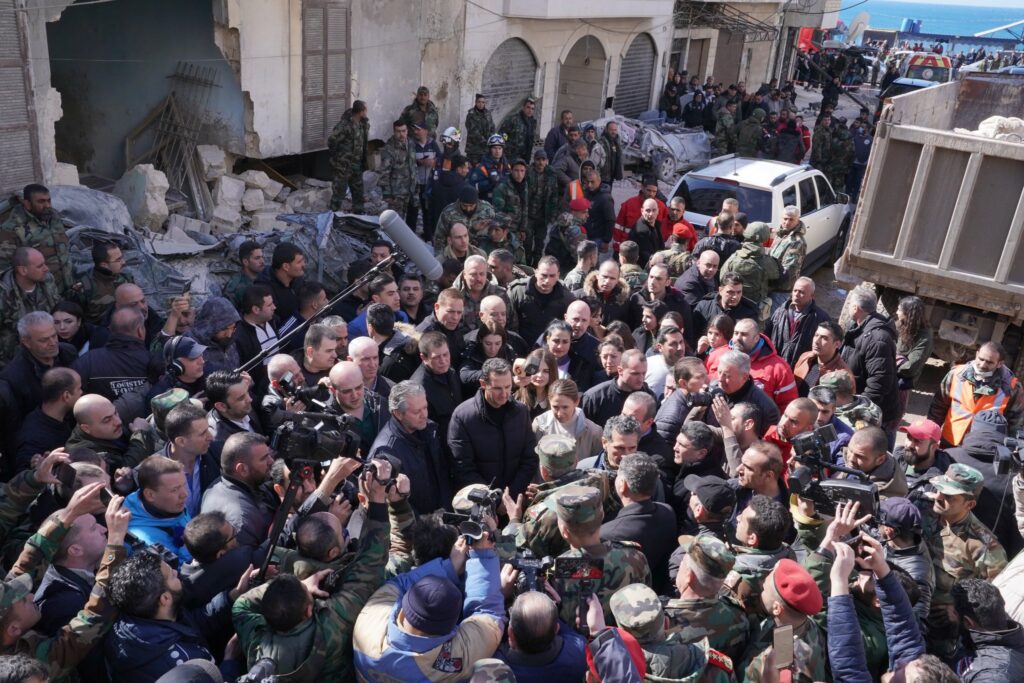
The US Agency for International Development announced the US government would provide $85 million in urgent humanitarian assistance for earthquake-hit Turkey and Syria.
Syrian President Bashar al-Assad visited the earthquake-hit areas for the first time.
Assad’s Twitter account was suspended after his posts criticising international charities. “Most organisations claim to support both Turkey and Syria, but only send their money to Turkey. I wonder who is stopping them? Hint: Not Syria,” Assad wrote before his account was suspended.
The United States eased sanctions on Syria in order to allow humanitarian aid to reach the country. A license was issued by the US Department of the Treasury’s Office of Foreign Assets Control (OFAC) which allowed earthquake relief to be carried out for 180 days.
Saturday, 11 February
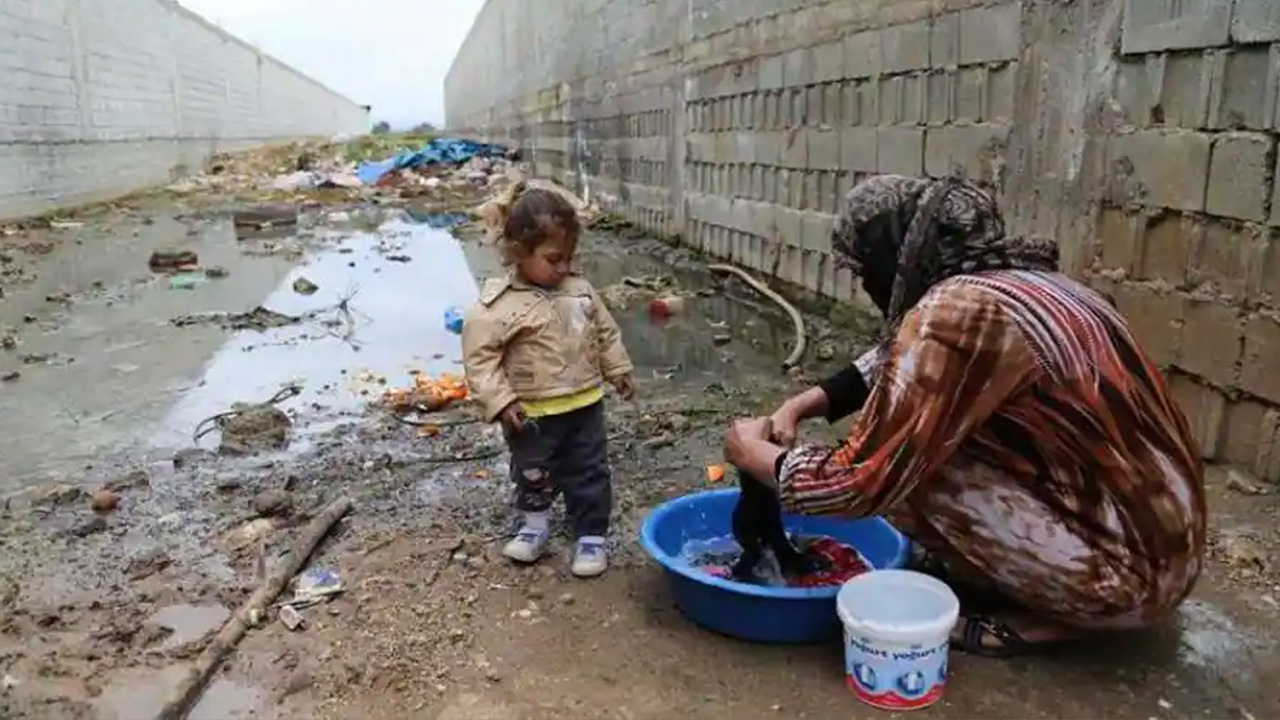
The UN announced that primary needs in the aftermath of the earthquake included medical supplies, heavy machines for rubble removal, food assistance, shelter and heating, emergency water, sanitation, and hygiene assistance. Lack of access to clean water and food had already been limited in northern Syria due to damaged infrastructure after years of war. The region was already trying to control a cholera outbreak, which had been raging across Syria since August, before the disaster. The UN reported 47,000 cholera cases as of 11 February.
Turkey’s Minister of Foreign Affairs Mevlüt Çavuşoğlu said that the Turkish authorities had been trying to open two other entry points to Syria after the Netherlands called on Ankara to open additional border gates to assist earthquake victims in the neighbouring country.
Jeremy Smith, the Middle East and North Africa country cluster manager for the British Red Cross, said the situation they were facing in Syria was a “nightmare scenario.” According to the UN Refugee Agency, nearly five and half million people may be left homeless in Syria, where some people had already been displaced 20 times since the start of the civil war in 2011.
The Turkish-backed Syrian rebels blocked aid being transferred to earthquake victims in Syria’s Idlib and Afrin, the head of the Kurdish-led SDF media centre said: “The denial of access to aid for those in need is recognised as a crime against humanity under international law, especially since thousands have died due to the lack of relief.”
Sunday, 12 February
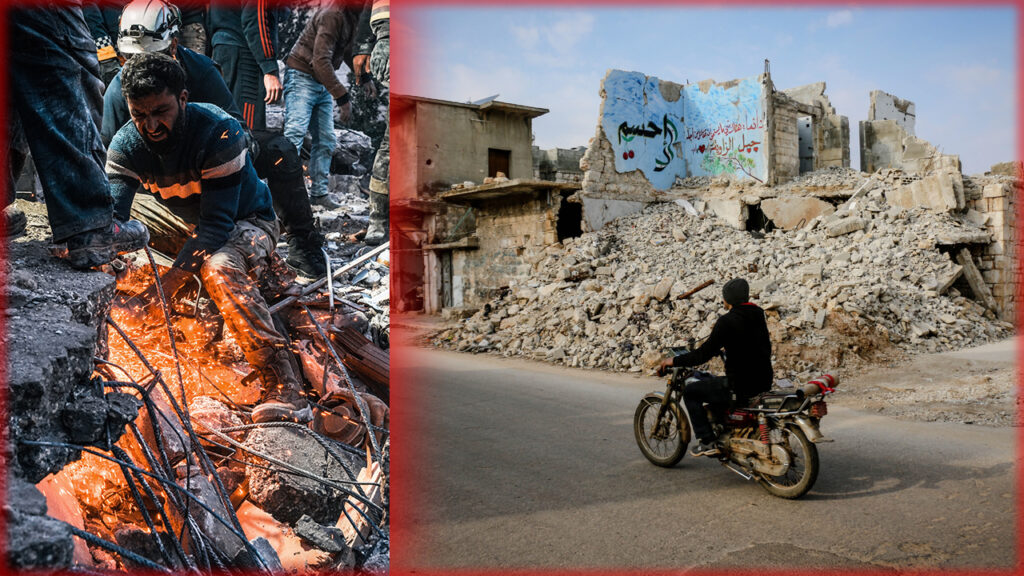
Observers claimed that the Damascus government was prioritising loyalist areas for the provision of humanitarian aid. However, there were also problems with aid received through Turkey and in Turkish-controlled areas of northern Syria. A UN official said that earthquake relief efforts were slowed down by issues with approval by the hardline Islamist group Hayat Tahrir al-Sham (HTS).
The devastating earthquakes did not stop Turkey from continuing its cross-border military attacks against Kurdish forces. A Turkish combat drone targeted a vehicle in North and East Syria.
Monday, 13 February

The United States called on the UN Security Council to immediately authorise the delivery of humanitarian aid to areas of rebel-held northwest Syria severely damaged in the twin earthquakes.
Since 2014, the UN had been delivering aid to northwest Syria through Turkey under a Security Council mandate, but it was restricted to a single border crossing. After long opposition from Damascus to cross-border aid deliveries to the rebel-held regions, Syrian President Bashar al-Assad agreed to temporarily allow earthquake aid to flow through two new border crossings from Turkey into areas of northern Syria under the control of opposition groups.
ISIS members killed 11 individuals. The killings raised concerns over a possible resurgence of ISIS after the jihadist group kidnapped 75 civilians in western Syria on 12 February, as locals and members of the international community in northern parts of the country were trying to cope with the massive destruction caused by the disaster.
Tuesday, 14 February
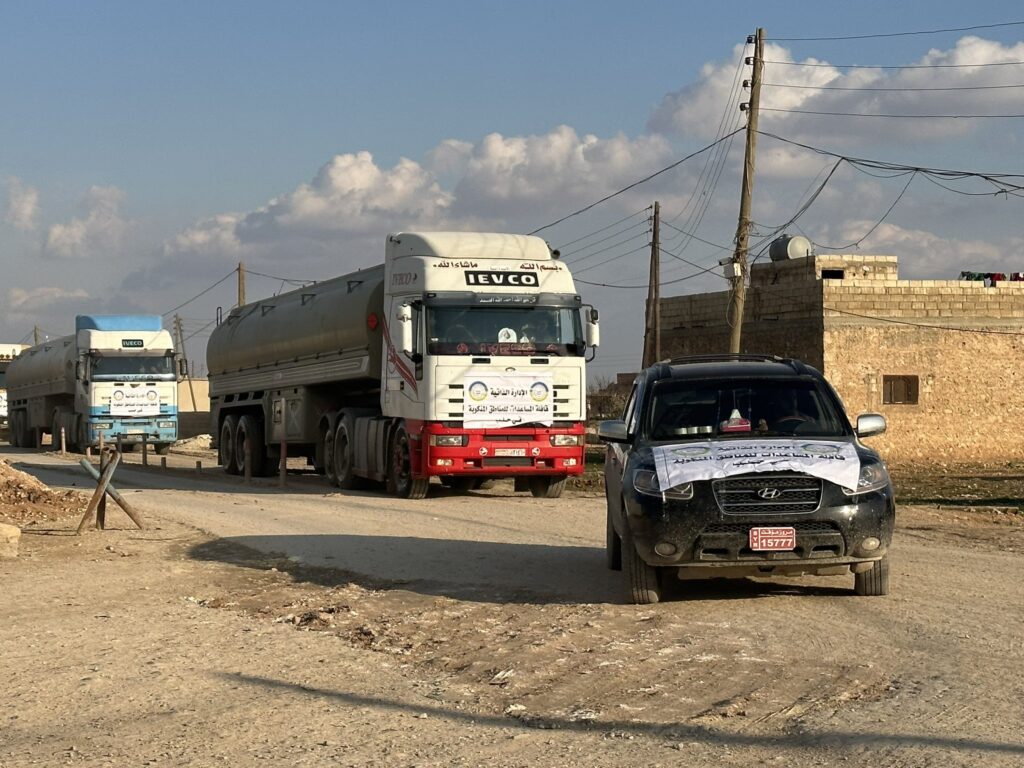
The first UN aid convoy entered rebel-controlled northwest Syria from Turkey through the newly opened Bab al-Salam border crossing.
Saudi Arabia sent its first reported aid to Assad-controlled Aleppo. Until then, the country had only delivered earthquake assistance to rebel-controlled areas.
An aid convoy of 50 lorries from the Kurdish-led AANES entered areas of Syria controlled by Turkish-backed opposition. AANES had previously announced that earthquake victims had been afraid to receive supplies sent by them, as rebel forces had been blocking humanitarian aid sent from the northeast.
Wednesday, 15 February
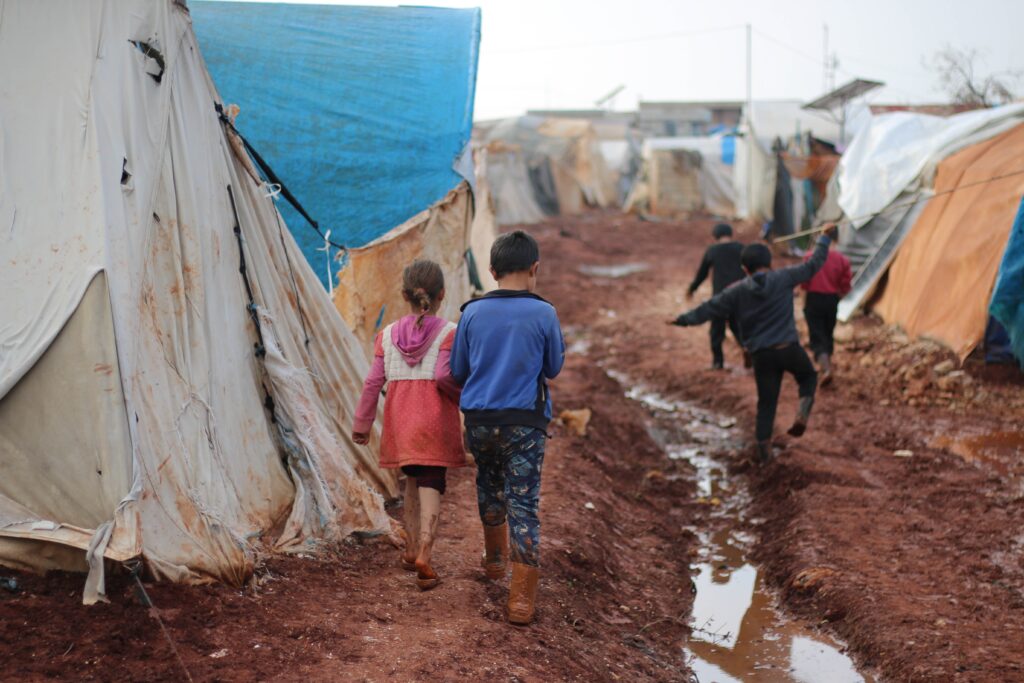
The major disaster affected 2.5 million children in Syria and many thousands of children died in the disaster. A spokesman for the UN children’s agency UNICEF noted that Syrian children under 12 had been born into a world of conflict, and some of them had already been displaced several times. “This would appear [to be] the international community’s last chance to show solidarity to these millions of children,” the spokesman said.
After Syrian border officials announced that Turkey would allow Syrian refugees living in the earthquake zone in Turkey and returning to their homeland for three to six months to come back to Turkey afterwards, thousands of Syrian refugees temporarily returned to Syria.
After days of waiting for approval, 100 convoys of fuel tanks sent by the AANES reached the Kurdish-majority regions of government-held Aleppo.
Thursday, 16 February
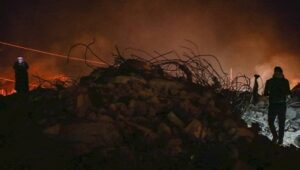
As well as closed border crossings, Turkish airstrikes compounded the suffering of Syrians in the area affected by the earthquakes. A 70-year-old man died in shelling in Tel Rifat, according to the reports.
Syrian government forces and opposition groups clashed in northwestern Syria, the Syrian Observatory for Human Rights (SOHR) reported. It was the first time armed clashes had taken place in the region since the disaster.
Friday, 17 February

The AANES withdrew an aid convoy that was prepared and waiting to enter earthquake-stricken regions in northwest Syria. The AANES’s attempts to deliver aid to the disaster zones under the control of the Turkish-backed opposition had been halted since 8 February as Turkish-backed opposition prevented the convoy from crossing. The administration decided to pull back the aid convoy consisting of 30 tanks of fuel after nine days of waiting for approval from the opposition.
Saturday, 18 February
The Directorate of Education in Aleppo suspended education in 80 schools due to damage sustained by the earthquake.
Sunday, 19 February
The Medical charity Medecins Sans Frontieres (MSF) announced that 14 of its lorries had entered northwestern Syria.
Monday, 20 February
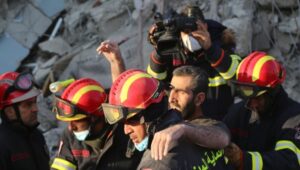
The delivery of post-disaster humanitarian aid to Syria picked up speed, although international organisations active in the region stated that some local authorities in northwest Syria were still blocking aid convoys.
The Damascus government was persuaded to open two more border crossings with Turkey to allow more aid to reach the northwest of the country.
Three people lost their lives and 339 others were injured in northern Syria after a new earthquake with a magnitude of 6.4 hit the already battered region. The three deaths were recorded in the government-held areas; one each in Hama, Safita and the countryside near Tartus. The earthquake further damaged buildings in the country that had been already weakened by the twin earthquakes of 6 February and the destruction caused by the 12-year civil war.
More than 1,500 bodies of Syrians who had died in the earthquakes in Turkey had arrived in Syria through the Bab al-Hawa border crossing since 6 February.
Syria’s death toll rose to 8,476. The figures does not include victims whose relatives buried them in Syrian territory shortly after the earthquake, even before the arrival of rescue teams.
Tuesday, 21 February
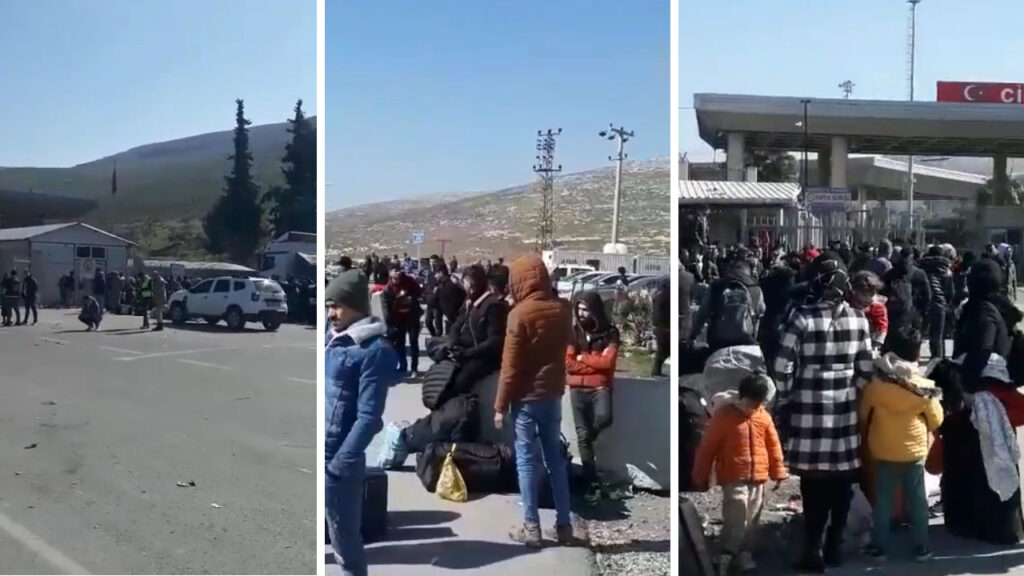
The European Union warned against the viral spread of food and water-borne diseases, respiratory infections, and vaccine-preventable infections in the coming weeks in areas in Turkey and Syria impacted by earthquakes.
The rivalry between groups controlling areas in Syria’s earthquake-hit northwest exacerbated the suffering of people coping with both the devastation of the recent tremors and the destruction of war.
More than 20.000 Syrians arrived in northwest Syria from Turkey, after Syrian border officials announced that refugees living in Turkey’s disaster zone can temporarily return to their homeland and be re-admitted to Turkey in three to six months.
Wednesday, 22 February
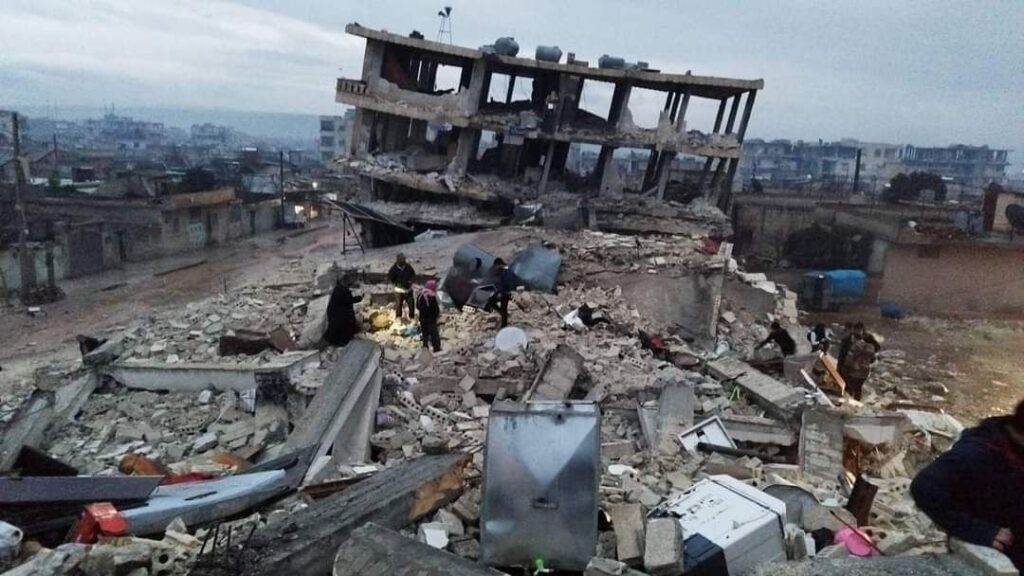
Noting that the earthquake has created a crisis within a crisis, UN Deputy Special Envoy for Syria called for an end to violence to enable humanitarian assistance to be delivered in all areas of Syria and to all Syrians.
A UN delegation visited northwest Syria to inspect damage. According to the UN website, 227 trucks loaded with supplies have crossed from Turkey to Syria since 9 February.
The earthquakes damaged seven hospitals and about 145 health facilities across Syria, the WHO said, “Many of these are in the north-west, which has been ravaged by war for more than a decade and is, therefore, more vulnerable to shocks like this.”
Thursday, 23 February
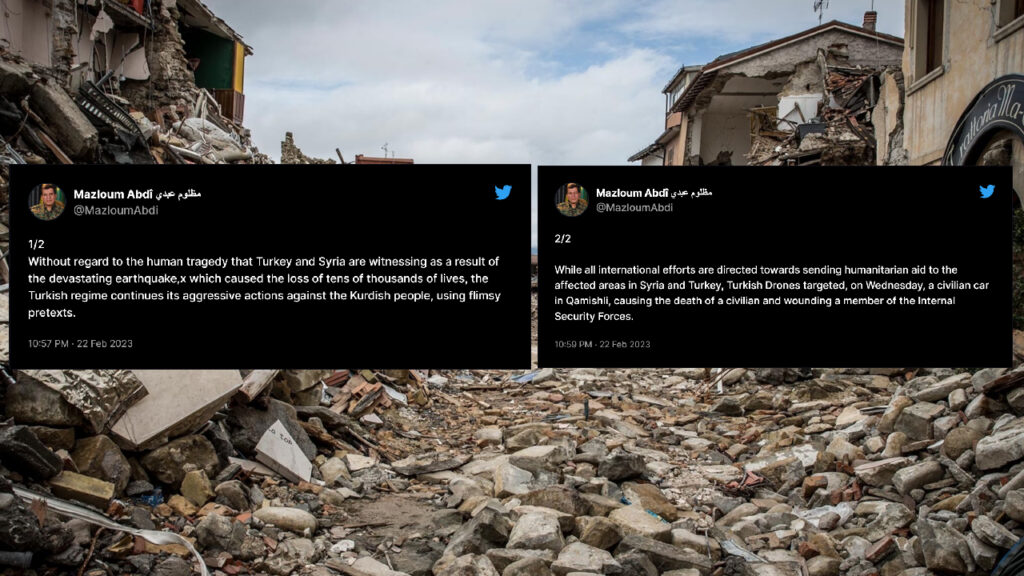
The European Union decided to ease sanctions on Syria for a period of six months to further facilitate the speedy delivery of humanitarian aid.
Turkish aggression against Kurds continued in northern Syria amid the human tragedy caused by the earthquakes in both countries, as a Turkish drone attacked a civilian car in Qamishli, killing one and injuring another. While all international efforts were directed towards sending humanitarian aid to the Syrian and Turkish people, “the Turkish regime continues its aggressive actions against the Kurdish people, using flimsy pretexts,” SDF Commander-in-Chief Mazloum Abdi said.
Friday, 24 February
Syria’s latest offical death toll rose to 5,914, with no less than 4,500 deaths reported in the opposition-held northwest.
Saturday, 25 February
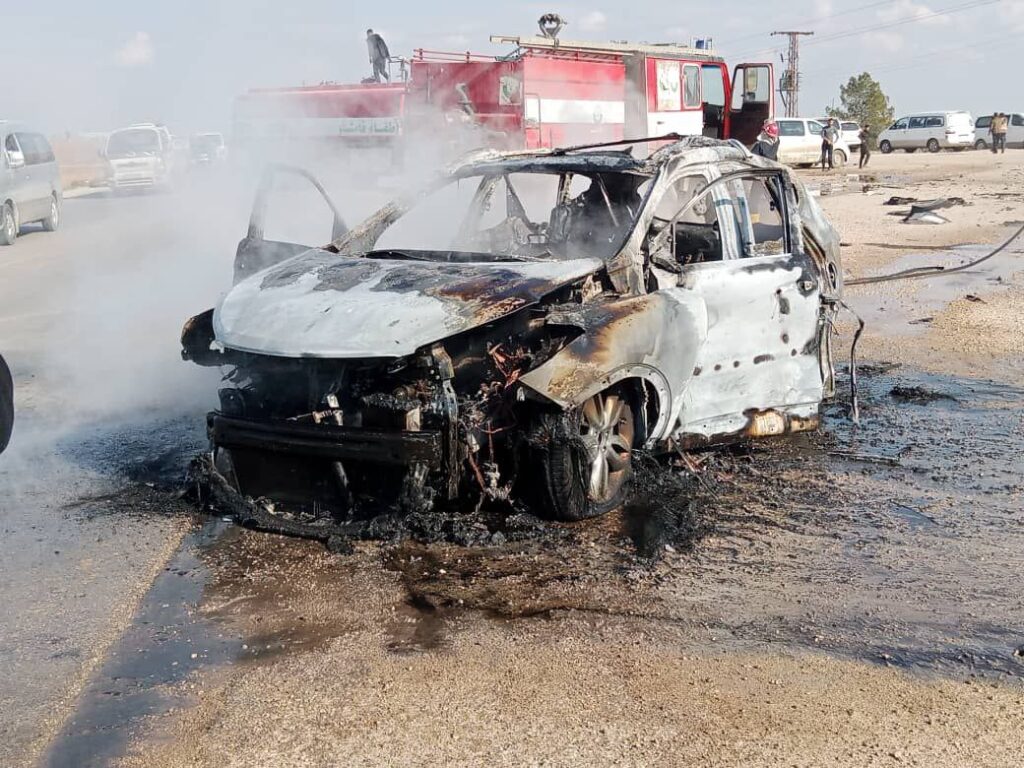
Amnesty International released a report detailing human rights violations by both Syrian and Turkish authorities in the aftermath of the disaster. Amnesty called on the Syrian and Turkish governments as well as armed opposition groups to immediately cease attacks in the region.
Turkish forces had launched 18 ground attacks and two air strikes on North and East Syria since the 6 February earthquakes, said SDF spokesman Farhad Shami, noting that these attacks had resulted in the deaths of two citizens. The spokesman argued that Turkey had taken advantage of the SDF’s decision to halt its military operations due to the disaster that hit both countries.
Sunday, 26 February
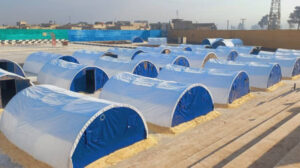
The Education Board of the AANES set up dozens of tents as classrooms in the northern countryside of Aleppo. The earthquakes damaged 25 schools in AANES-held areas in Aleppo, ten of which collapsed.
Tuesday, 28 February
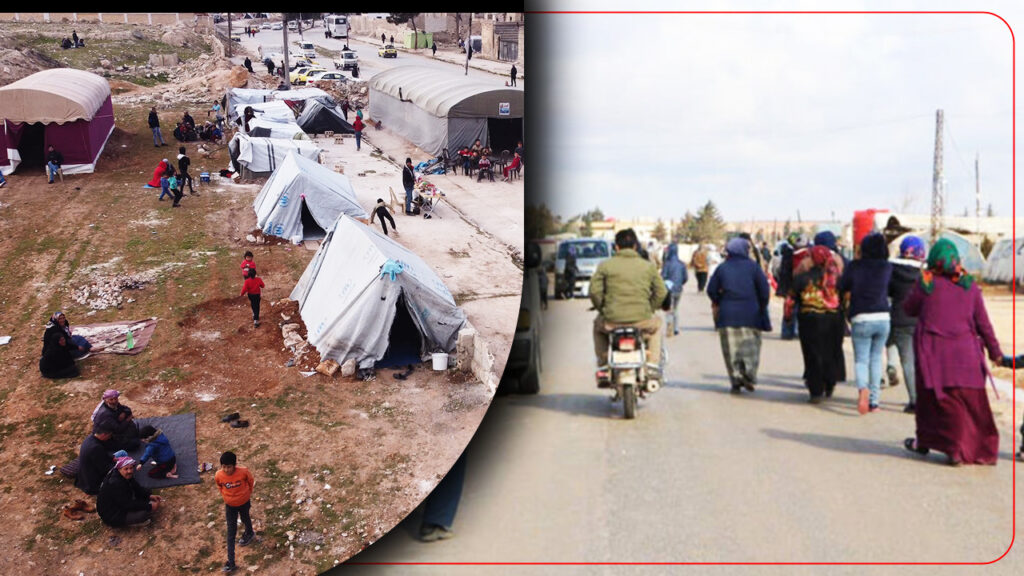
Shelters housing quake survivors in northwest Syria saw a high number of scabies cases, along with a shortage of water.
The number of Syrians arriving in northwest Syria from Turkey’s quake-hit provinces rose to 41.023, according to the administration of the Bab al-Hawa border crossing between Turkey and Syria’s Idlib Governorate.
The Regional Council of Shahba, a region affiliated with the Kurdish-led autonomous administration in Aleppo’s northern countryside, stated that earthquake victims in north and east Syria were still in desperate need of aid. Following the quake, around 20,000 people from the city of Aleppo descended on the region, where around 300,000 displaced Kurdish inhabitants had already been taking shelter after Turkey took control of Afrin in 2018.
The Kurdish-led autonomous administration passed new standards regarding earthquake-proof construction, and would monitor damage to the nearly 90 schools and 650 civilian buildings registered with the planning office.
Wednesday, 1 March
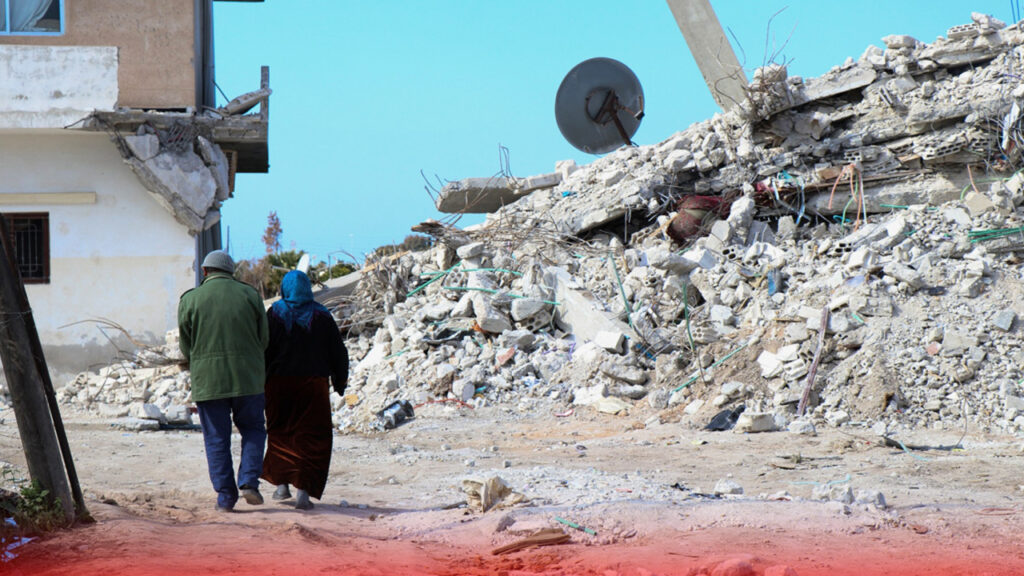
The only United Nations–authorised border crossing into Syria from Turkey was closed for four days following the earthquake, and it was only after a week that the UN reached an agreement with Damascus to open two more crossing points. As the focus shifts from rescue to recovery in both countries, concerns have been raised about the impact of sanctions imposed on Syria on aid efforts.
Friday, 3 March
The Kurdistan Red Crescent Society announced that the organisation has spent some 1.8 million euros ($1.9 million) to date on relief efforts, with 1.5 million euros going to southeast Turkey and 300,000 to north and east Syria.
Monday, 6 March
UNICEF revealed that more than 500,000 people in Syria have been displaced by the devastating earthquake.
Tuesday, 7 March
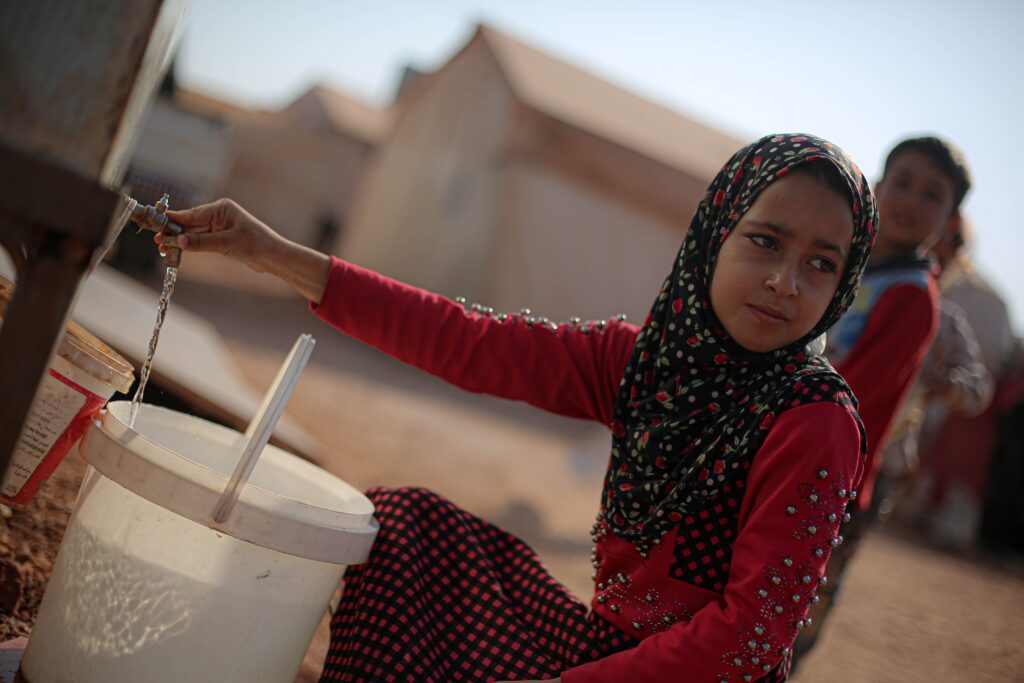
The International Committee of the Red Cross (ICRC) has warned that Syria’s ageing and war-damaged water system in the northwestern province of Aleppo is at risk of collapse following the earthquakes that struck the area one month ago.
Wednesday, 8 March
Amnesty International has reported that the Syrian government and Turkish-backed factions have blocked over 100 trucks carrying aid to two areas in Aleppo province that were hit by the earthquakes on 6 February.
Monday, 13 March
The UN-backed Independent International Commission of Inquiry on Syria has criticised the international community and Syria’s government for not acting fast enough to help those in need in the northwest of the country.
More than 6,500 foreign nationals, mostly Syrians, were killed by the disaster in Turkey, Turkish Interior Minister Süleyman Soylu said.
Friday, 17 March
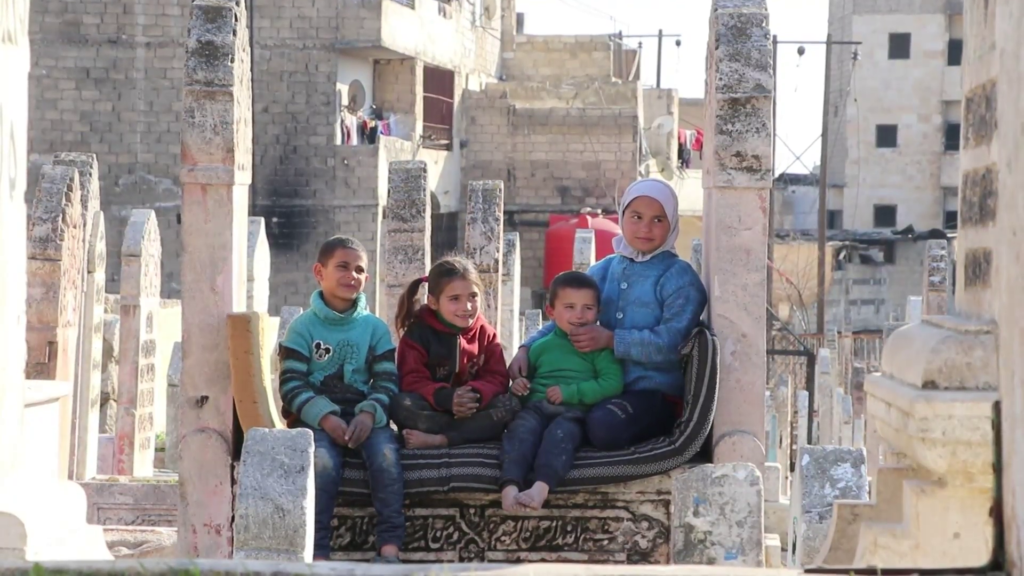
People in collective shelters continue to show signs of severe panic attacks, distress, insomnia, and disorientation 40 days after the earthquake, highlighting the continued need for long-term psychosocial support interventions, the OCHA reports.
Over 150,000 families are still without adequate shelter in Syria. Besides the loss of homes, around 454 schools are reported to have been destroyed following the deadly earthquakes.










